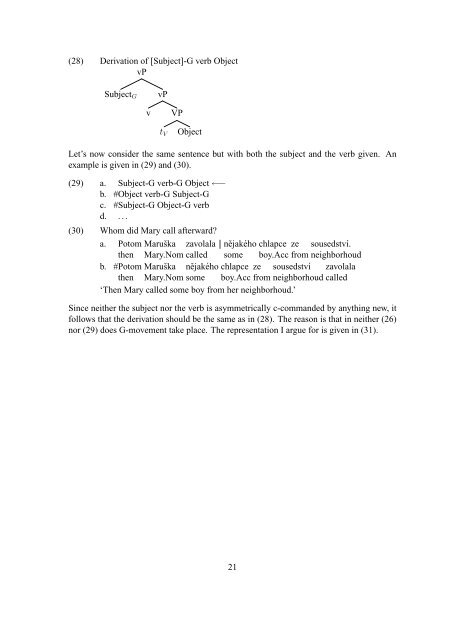The Syntax of Givenness Ivona Kucerová
The Syntax of Givenness Ivona Kucerová The Syntax of Givenness Ivona Kucerová
c. #Subject-G Object verb d. . . . (27) What did Mary do afterward? a. (Potom) Maruška || zavolala nějakého chlapce ze sousedství. afterward Mary.Nom called some boy.Acc from neighborhood b. #(Potom) Maruška nějakého chlapce ze sousedství zavolala afterward Mary.Nom some boy.Acc from neighborhood called ‘Afterward Mary called some boy from her neighborhood.’ I have proposed in 1.1 that G-movement is a last resort operation. We predict that G- movement takes place only if there is a non-G element asymmetrically c-commanding the given subject. Since there is no such element, in this particular case there is no G-movement taking place. A corresponding tree representation is given in (28). 20
(28) Derivation of [Subject]-G verb Object vP Subject G vP v VP t V Object Let’s now consider the same sentence but with both the subject and the verb given. An example is given in (29) and (30). (29) a. Subject-G verb-G Object ←− b. #Object verb-G Subject-G c. #Subject-G Object-G verb d. . . . (30) Whom did Mary call afterward? a. Potom Maruška zavolala || nějakého chlapce ze sousedství. then Mary.Nom called some boy.Acc from neighborhoud b. #Potom Maruška nějakého chlapce ze sousedství zavolala then Mary.Nom some boy.Acc from neighborhoud called ‘Then Mary called some boy from her neighborhoud.’ Since neither the subject nor the verb is asymmetrically c-commanded by anything new, it follows that the derivation should be the same as in (28). The reason is that in neither (26) nor (29) does G-movement take place. The representation I argue for is given in (31). 21
- Page 1 and 2: The Syntax of Givenness by Ivona Ku
- Page 3 and 4: Acknowledgments Two things were dif
- Page 5 and 6: A.4 A note on base generation . . .
- Page 7 and 8: (2) a. SVO: Chlapec našel lízátk
- Page 9 and 10: accent on the auxiliary did in (4-a
- Page 11 and 12: Pitch (Hz) 500 400 300 200 100 0 ch
- Page 13 and 14: (6) Petr řídil včera rychle auto
- Page 15 and 16: phrases are required to undergo G-m
- Page 17 and 18: . A entails (α,U) where (α,U) is
- Page 19: (23) What can be understood as new?
- Page 23 and 24: functionalist tradition there has b
- Page 25 and 26: c. ?P v-V vP Subject vP v-V VP V Ob
- Page 27 and 28: (40) What happened to the antique c
- Page 29 and 30: movement is possible. (47) a. Why d
- Page 31 and 32: TP Aux vP money vP gave VP t money
- Page 33 and 34: TP Aux TP T vP t Aux VP money VP gi
- Page 35 and 36: c. #Jeho viděla Marie na nádraž
- Page 37 and 38: (63) a. #Diskuse proběhla bez věd
- Page 39 and 40: (70) a. #Žáky a učitelku to pře
- Page 41 and 42: Chapter 2 G-movement In chapter 1,
- Page 43 and 44: asic word order cases we expect wor
- Page 45 and 46: (9) a. What happened? b. #[Vlak př
- Page 47 and 48: . ?P DO vP subject vP v VP V VP IO
- Page 49 and 50: . vP subject vP v VP V ?P DO VP IO
- Page 51 and 52: . Marie [ vP včera dala [ V P rych
- Page 53 and 54: vP Marie vP yesterday vP gave VP qu
- Page 55 and 56: list reading. No such requirement e
- Page 57 and 58: poskytovat jídlo. provide food.Acc
- Page 59 and 60: a. X X X Z X X α b. X α X X X Z X
- Page 61 and 62: existing Agree relation in case it
- Page 63 and 64: 2.4 Summary In this chapter, I have
- Page 65 and 66: 3.1 Deriving the verb partition In
- Page 67 and 68: We will see in the next section how
- Page 69 and 70: e. vP subject vP DO vP v VP v V DO
(28) Derivation <strong>of</strong> [Subject]-G verb Object<br />
vP<br />
Subject G<br />
vP<br />
v<br />
VP<br />
t V<br />
Object<br />
Let’s now consider the same sentence but with both the subject and the verb given. An<br />
example is given in (29) and (30).<br />
(29) a. Subject-G verb-G Object ←−<br />
b. #Object verb-G Subject-G<br />
c. #Subject-G Object-G verb<br />
d. . . .<br />
(30) Whom did Mary call afterward?<br />
a. Potom Maruška zavolala || nějakého chlapce ze sousedství.<br />
then Mary.Nom called some boy.Acc from neighborhoud<br />
b. #Potom Maruška nějakého chlapce ze sousedství zavolala<br />
then Mary.Nom some boy.Acc from neighborhoud called<br />
‘<strong>The</strong>n Mary called some boy from her neighborhoud.’<br />
Since neither the subject nor the verb is asymmetrically c-commanded by anything new, it<br />
follows that the derivation should be the same as in (28). <strong>The</strong> reason is that in neither (26)<br />
nor (29) does G-movement take place. <strong>The</strong> representation I argue for is given in (31).<br />
21



